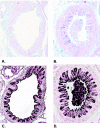Human metapneumovirus persists in BALB/c mice despite the presence of neutralizing antibodies
- PMID: 15564507
- PMCID: PMC533920
- DOI: 10.1128/JVI.78.24.14003-14011.2004
Human metapneumovirus persists in BALB/c mice despite the presence of neutralizing antibodies
Abstract
Human metapneumovirus (HMPV) has emerged as an important human respiratory pathogen causing upper and lower respiratory tract infections in young children and older adults. Recent epidemiological evidence indicates that HMPV may cocirculate with respiratory syncytial virus, and HMPV infection has been associated with other respiratory diseases. In this study, we show that BALB/c mice are susceptible to HMPV infection, the virus replicates in the lungs with biphasic growth kinetics in which peak titers occur at days 7 and 14 postinfection (p.i.), and infectious HMPV can be recovered from lungs up to day 60 p.i. In addition, we show that genomic HMPV RNA can be detected in the lungs for >/=180 days p.i. by reverse transcription-PCR; however, neither HMPV RNA nor infectious virus can be detected in serum, spleen, kidneys, heart, trachea, and brain tissue. Lung histopathology revealed prevalent mononuclear cell infiltration in the interstitium beginning at day 2 p.i. and peaking at day 4 p.i. which decreased by day 14 p.i. and was associated with airway remodeling. Increased mucus production evident at day 2 p.i. was concordant with increased bronchial and bronchiolar inflammation. HMPV-specific antibodies were detected by day 14 p.i., neutralizing antibody titers reached >/=6.46 log(2) end-point titers by day 28 p.i., and depletion of T cells or NK cells resulted in increased HMPV titers in the lungs, suggesting some immune control of viral persistence. This study shows that BALB/c mice are amenable for HMPV studies and indicates that HMPV persists as infectious virus in the lungs of normal mice for several weeks postinfection.
Figures






Similar articles
-
Immune response and alteration of pulmonary function after primary human metapneumovirus (hMPV) infection of BALB/c mice.Vaccine. 2005 Aug 22;23(36):4473-80. doi: 10.1016/j.vaccine.2005.04.027. Vaccine. 2005. PMID: 15927322
-
Serological cross-reactivity of members of the Metapneumovirus genus.Virus Res. 2004 Sep 15;105(1):67-73. doi: 10.1016/j.virusres.2004.04.019. Virus Res. 2004. PMID: 15325082
-
Cytotoxic T-lymphocyte epitope vaccination protects against human metapneumovirus infection and disease in mice.J Virol. 2006 Feb;80(4):2034-44. doi: 10.1128/JVI.80.4.2034-2044.2006. J Virol. 2006. PMID: 16439559 Free PMC article.
-
Cell-Mediated Responses to Human Metapneumovirus Infection.Viruses. 2020 May 14;12(5):542. doi: 10.3390/v12050542. Viruses. 2020. PMID: 32423043 Free PMC article. Review.
-
The distinguishing features of human metapneumovirus and respiratory syncytial virus.Rev Med Virol. 2010 Jul;20(4):245-60. doi: 10.1002/rmv.651. Rev Med Virol. 2010. PMID: 20586081 Review.
Cited by
-
Motavizumab, a neutralizing anti-Respiratory Syncytial Virus (Rsv) monoclonal antibody significantly modifies the local and systemic cytokine responses induced by Rsv in the mouse model.Virol J. 2007 Oct 25;4:109. doi: 10.1186/1743-422X-4-109. Virol J. 2007. PMID: 17961258 Free PMC article.
-
Innate Immune Components that Regulate the Pathogenesis and Resolution of hRSV and hMPV Infections.Viruses. 2020 Jun 12;12(6):637. doi: 10.3390/v12060637. Viruses. 2020. PMID: 32545470 Free PMC article. Review.
-
Human monoclonal antibodies protect against viral-mediated pneumococcal superinfection.Front Immunol. 2024 Jun 12;15:1364622. doi: 10.3389/fimmu.2024.1364622. eCollection 2024. Front Immunol. 2024. PMID: 38933273 Free PMC article.
-
Identification and evaluation of a highly effective fusion inhibitor for human metapneumovirus.Antimicrob Agents Chemother. 2008 Jan;52(1):279-87. doi: 10.1128/AAC.00793-07. Epub 2007 Oct 29. Antimicrob Agents Chemother. 2008. PMID: 17967906 Free PMC article.
-
Human metapneumovirus glycoprotein G inhibits innate immune responses.PLoS Pathog. 2008 May 30;4(5):e1000077. doi: 10.1371/journal.ppat.1000077. PLoS Pathog. 2008. PMID: 18516301 Free PMC article.
References
-
- Ahmed, R., L. A. Morrison, and D. M. Knipe. 1996. Persistence of viruses, p. 219-249. In B. N. Fields, D. M. Knipe, P. M. Howley, R. M. Chanock, J. L. Melnick, T. P. Monath, B. Roizman, and S. E. Straus (ed.), Fields virology, 3rd ed., vol. 1. Lippincott Williams & Wilkins, Philadelphia, Pa.
-
- Alvarez, R., L. P. Jones, B. S. Seal, D. R. Kapczynski, and R. A. Tripp. 2004. Serological cross-reactivity of members of the Metapneumovirus genus. Virus Res. 105:67-73. - PubMed
-
- Belshe, R. B., L. S. Richardson, W. T. London, D. L. Sly, J. H. Lorfeld, E. Camargo, D. A. Prevar, and R. M. Chanock. 1977. Experimental respiratory syncytial virus infection of four species of primates. J. Med. Virol. 1:157-162. - PubMed
-
- Boivin, G., Y. Abed, G. Pelletier, L. Ruel, D. Moisan, S. Côté, T. C. Peret, D. D. Erdman, and L. J. Anderson. 2002. Virological features and clinical manifestations associated with human metapneumovirus: a new paramyxovirus responsible for acute respiratory-tract infections in all age groups. J. Infect. Dis. 186:1330-1334. - PubMed
Publication types
MeSH terms
Substances
LinkOut - more resources
Full Text Sources
Other Literature Sources

